Episode #17: The Evolution of Travel Content and What’s Next with MakeMy Trip’s Ankita Sharma
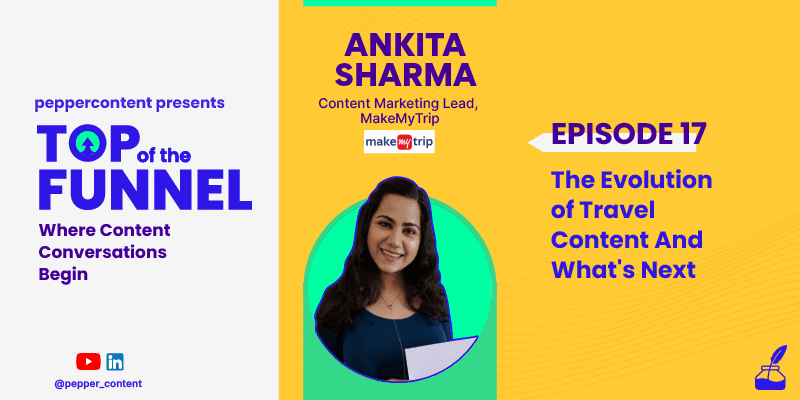
The pandemic brought the whole world to a standstill, meaning the travel industry took the most hits. MakeMy Trip is an online travel company that provides flight tickets, hotel reservations, domestic and international tour packages, and tips to make your travel experience an enjoyable experience. The dynamism and adaptability of travel content marketing are a part of its charm. Natasha Puri, Content Marketing Lead at Pepper Content, talks to Ankita Sharma, Content Marketing Lead at Make My trip about the evolution of content in the travel sector.
Ankita Sharma talks of using updated technology and ongoing trends to drive customer focus. She delves deep into using data-driven models to steer the course of travel content marketing. Being at the helm of the content marketing team in MakeMy Trip, she cited that creating customer-focused relevant content is the only way to stay afloat in such changing times.
Natasha Puri: Hello everyone. Welcome to Top of the Funnel, the series where conversations about content begin. Our guest today is Ankita Sharma, Content Marketing Lead, at Make my Trip. This chat promises to be very informative and insightful. Ankita Sharma is at the helm of all things content in Make my Trip. She will take us through the evolution of travel content from the pre-pandemic to the post-pandemic times.
What is the role of content in the travel business?
Ankita Sharma: The role of content is essential in the travel business because it is through content that you are driving the entire life cycle of a customer. From something as simple as building inspiration first, establishing the idea of travel for people who have not adopted it to people who are looking to travel, content plays an important role. The next step is to build aspiration. Content will push someone from traveling to domestic locations to going for small, international trips. Someone who has been going to Thailand may pick Europe. The whole idea is to create inspiration and move towards aspiration. The most essential element is creating FOMO for people. Travel content puts out the messaging that you are missing out on something essential, something so fun that aspiration takes over. This is where you have to use the content to guide the action.
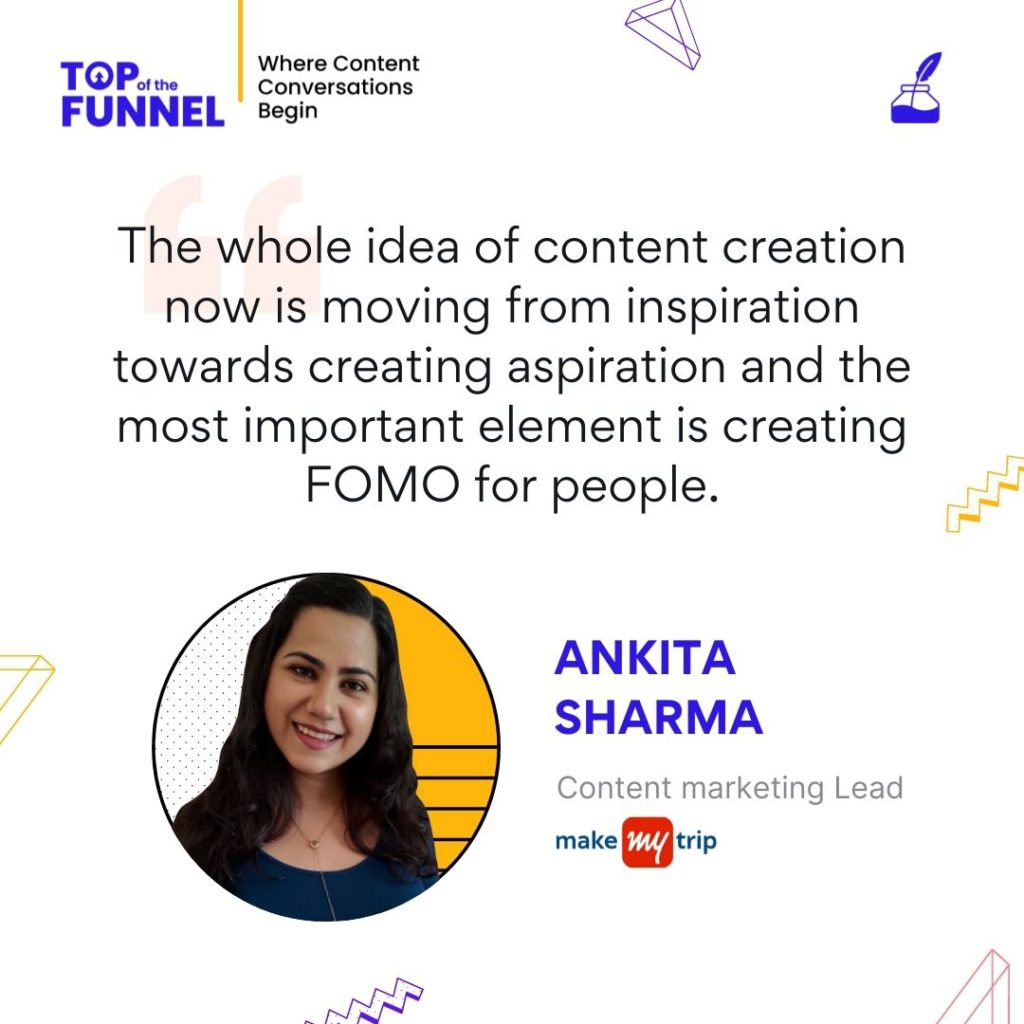
Natasha Puri: What is the role of travel content in the pandemic? It has completely changed for you and others in the travel industry. Could you talk a bit about it?
Ankita Sharma: This has been a stage of consolidation for a lot of us. Right now, we are working on something day in and day out called information. They may be domestic guidelines or international guidelines. If we speak about our app, we have sections for both of these. Any information you need in terms of what kind of guidelines you need to follow, or information on covid test reports, the duration of tests like it has to be before 7 hrs or 12 hrs, such specific information is listed on our app.
We have a dedicated team, the one that I am heading, where we are in continuous contact with media, following up with government agencies, and airlines to put all this information in one place and make it easier to understand. The government is coming up with so many circulars and things are changing very rapidly. Also, your customers are worried about it. Right now, our role is to give the right information.
For example, when someone is booking a ticket, they have to know that they need an RT/PCR test report from 72 hours before their journey. If they do not have those documents, the airline won’t let them pass. There have been so many instances where people have suffered through lots of hassles during travel. So, we have made it a point to give the right information to keep people safe.
Also, essential travel is not going anywhere. While there was a complete lockdown, it has gone for a while now. There are guidelines. People are traveling. There are businesses, which are still working. So, you have traffic in the air. There are people, who are still booking trains. Hence, information is required also in terms of what kind of hotels should customers look for.
What kind of safety protocols are they following? What to do if you are stuck somewhere, and need to quarantine in a hotel? Content has worked on so many levels, to deliver information on assured hotels, to ensure that all of it is taken care of to ensure some peace of mind for the traveler. Content has been a big help for marketing in terms of providing the right information in terms of safety.
Natasha Puri: At this point, I think the content has become more important than ever, from aspirational content to safety as a key message. Content has become the key messaging pillar. It is quite interesting as such times have prompted marketing teams to look within and define that the most important role of the organization, other than the processes.
Ankita Sharma: The usual business goes on. What we need to do right now is to give some peace and comfort to our customers. This is where content has come around and helped marketing teams do this.
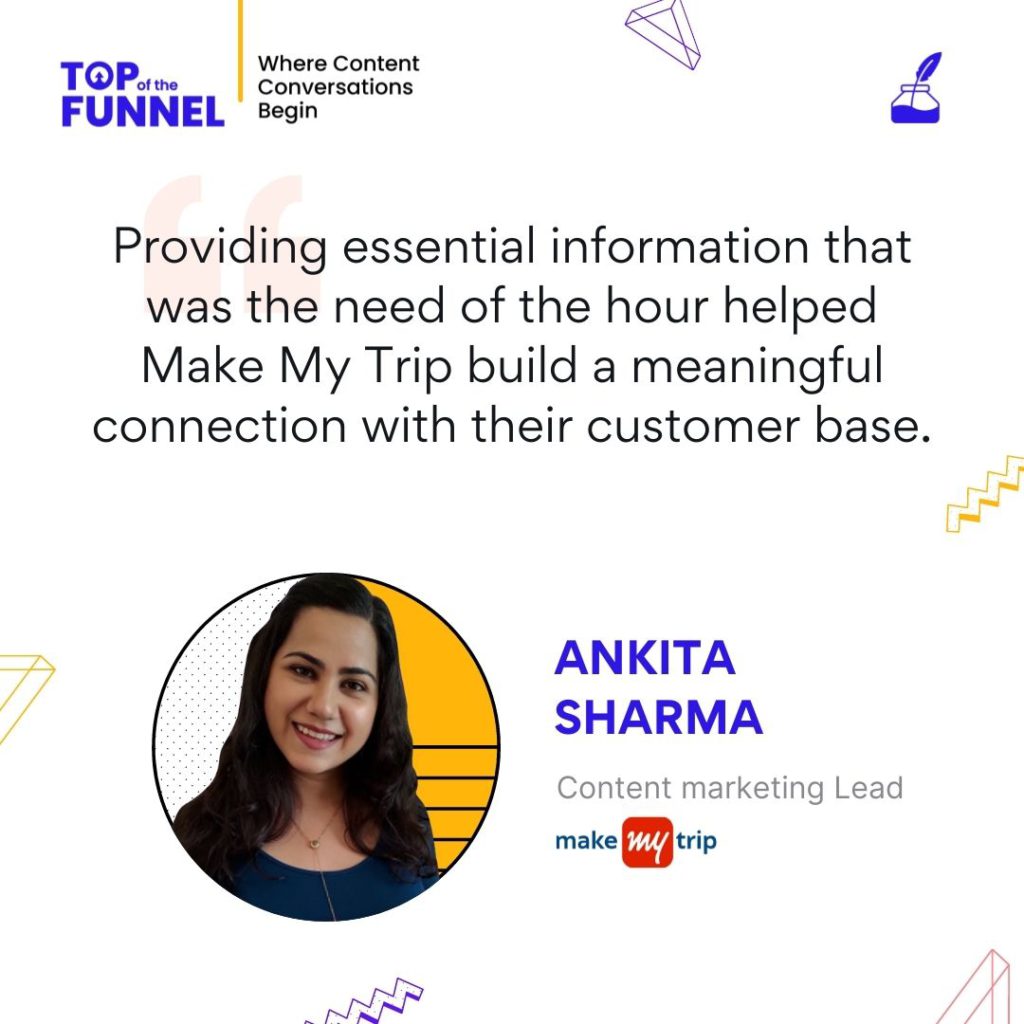
Natasha Puri: How is your content marketing strategy different from your competitors, considering that travel content has been so saturated for a while. How do you distinguish between yourself and your competition? There are also so many independent content creators, creating content around travel. What is your take on that?
Ankita Sharma: We have to be agile. If there are so many influencers making travel content, why not start there? If that is what customers are looking for, why not give that content? Then, we can differentiate ourselves from them. If I look at how we are setting ourselves apart, we are just going with the flow.
From a realm of saturated content, we have moved away from those really-long, 2000 word articles like ‘What you can do in an X place?’, or ‘top 10 things to do in a place, and so on. We have moved onto bite-sized content like ‘Jaipur in a minute’, or ‘Jaipur in 2 mins.’
It will tell our customers what they want to know, in a way that they would like to know that. The agility has helped in setting us apart from our competitors.
You can look at one of the sections on the Make my Trip app, or website which is ‘Trip Ideas.’ It is a culmination of all of these. You have bite-sized content in terms of videos that the Make my Trip team has put out. We have a large collection of influencers on our platform. We have their versions and videos too. This is the kind of content that the customers are wanting these days. They can find it on any influencer’s page, and also on our website. This is how we are differentiating ourselves. And, ‘Trip Ideas’ is getting terrific traffic.
Natasha Puri: Creating content along the lifecycle of a customer, as you mentioned before, also plays a big role. You are not creating aspirational content aimlessly. It is extremely targeted at different segments in terms of the customers, right?
Ankita Sharma: Sales, or the customer management lifecycle would show that the kind of content we are pitching for different customers are very different, not only in terms of age but also about choices. I won’t get into too much detail on how we segregate customers, but the kind of segmentation that we do is very targeted. For example, content could be specifically built for a group of 17 target audiences. We have a very crystal clear focus in terms of what we want to say to our customers.
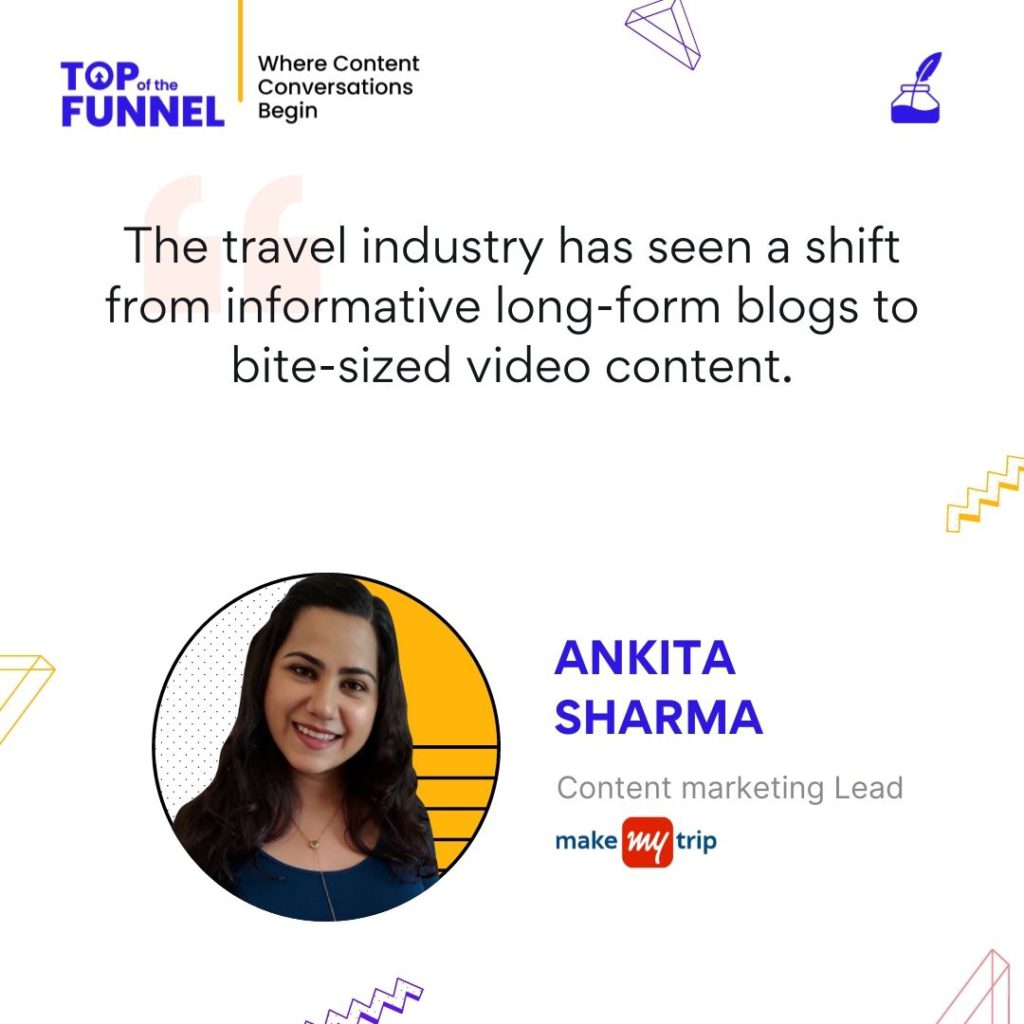
Natasha Puri: Is it essentially powered by data then?
Ankita Sharma: In content, if you are looking at a notification, you are looking at the click-through rate. Everything that we write from emailers to banners, we calibrate in terms of data. Is it working? If it is not working, we keep innovating and trying new things every time. We tried this storytelling segment, which worked really well for some people, but did not do well in other cases.
Natasha Puri: You have been in the content industry, also at Make my Trip for quite some time now. What do you think works best, when it comes to content collaborating with other teams? Where do you think the anchor lies? What works for Make my Trip and what does not work for Make my Trip?
Ankita Sharma: When content works with product, there has to be some return on business. The minute business sees a return in what content is doing for them, they will start following them. They will approach you for more things. And, the content will become part of the decision-making process. This is something we have managed to do with Make my Trip. We have tried to create value in terms of our different lines of business, and so on. Content is generally seen as a support function but when content really adds value, it is no longer a support function.
For online businesses like Make my Trip, content does not have to just be of one format. You have to keep innovating. If you do not experiment with new formats, you will be boring and will always remain as the support function. The minute you know what to do and help them to make a decision, get involved in giving the right messaging and the right information to customers, inspiring the right action, that’s where you add value to the business. Or, if your notifications and emailers are inspiring action and you are getting more shoppers, content also gets a chance to innovate. And, this innovation helps to add value to content. When you run continuous experimentation with content and figure out your customer needs, that is where businesses see the value in the content. This is how we can work with many lines of businesses within MakeMyTrip.
Natasha Puri: Sometimes, content teams struggle to add that value, that purpose to the organization, unless it is integral to the functions of that organization. We have to constantly innovate and experiment. This is a great tip for every content marketer out there. Are there any campaigns that worked especially well for you? What are the kind of metrics that you look at to prove that success? If you are a content person, you have to constantly prove your value everywhere.
Ankita Sharma: Every time people think of content they think of a social media campaign. We have done some amazing social media campaigns, one for women’s day, a vaccination campaign, a video-making campaign that even won an award recently. The social media campaign is very easy to measure and everyone keeps looking at it. It can be measured in terms of engagements, but I would rather focus on internal campaigns.
If I were to think of a content project more than a campaign, it would be the entire content that we did for our chatbot. It is like a problem-solving campaign project.
Myra is the name of the Make my Trip bot. We worked on the entire messaging. 30,000 to 40,000 messages were written so that the consumer can easily go through all the levels and figure out a solution for themselves. This is where we add value.
Another project that I would like to mention is that we have worked on creating videos for our hotel partners. When a customer is booking a hotel, they would look at the pictures and the particulars. We have worked to create around 2000 odd videos for our main hotel partners. It helps the customer. A video shows you exactly as it is, the hotel rooms, the amenities that you should use, the restaurants that you should try, and so on. This kind of campaign gives value, and helps that consumer to make a decision, and to hit that ‘book’ button.
Social media is filled with so many campaigns. The vaccination drive that we did recently was a huge hit in the pandemic. We sent out the message that your first stop should be the vaccination center, and the next stop is maybe Bangkok or the Philippines. This kind of campaign stands out and has been a huge help to us.
Natasha Puri: Where does your blog fit into your content strategy? Do you think it is still relevant? Or, it was relevant a few years back and now it is more Instagram and video-driven.
Ankita Sharma: Blog used to be an integral part of Make my Trip since 6 years back, but we have moved on from there. We have moved on to bite-sized content. We have a huge repository of blogs, travel guidelines, and all. But, we are focusing more on bite-sized content that can be easily consumed on apps or different channels like social media.
Natasha Puri: From what I understand, you are handling the corporate side of communication at Make my Trip. While the traditional understanding of travel content is very customer-focused, the B2C side of it. We often do not talk about the B2B side, which is the corporate part of it. The B2B content also has to be created as it powers the organization in a big way. Can you talk to us a bit about how the B2B side of content differs from the B2C side? Could you talk a bit more about the B2B side of content marketing in travel content?
Ankita Sharma: In the past 6 years, I began working with the B2C side of things. Then, I moved on to create a niche for myself in the B2B side of it. You have quite a few different channels for B2B. Although Make my Trip is a customer-focused company, you have My Bizz, My partner, and ad-tech partners, our hotel partners, and so on. There is lot of communication happening along these similar lines of businesses. While Make my Trip is a customer-focused company, My Bizz works on the corporate side of things. You have a lot of messaging there. My partner is only for travel agents. It is an entirely different platform there. These are similar lines of businesses, but you are selling to the customers and the business as well.
The approach is very different for customers and business customers. You are looking for saving time, finding the right deals, and efficiency when it comes to B2B companies. The right kind of messaging there is a mix of videos and bite-sized content. It ensures efficiency throughout the process. Communication for them is very focused.
It does not need a lot of fluff. It is not about driving their business and also running our own business. We have office-goers traveling for business, office admins booking tickets for everyone, and so on. It is not about driving their sale, but helping them to do this as efficiently as possible, maybe helping them out with GST drafts. This is where efficient, user-friendly platforms and special tools make a difference.
When you have a different audience like ad-tech, where your partners are advertising with you to build different kinds of campaigns for them, it should be a mix of customer and business friendly relationships. You have got a lot of scope within the business. You have UX writing, which is also a part of the business. You have specific tools for these customers that can help them work efficiently. This is where MakeMyTrip technology also comes in. As a proprietary platform, we have many tools that help our audience and drive the right messaging across platforms, informing them how it will work for them.
Natasha Puri: This was so interesting. This is a part of travel content that is not spoken about much. It seems direct, but you have to handhold people into learning that new technology. Again, the role of content becomes important there. We have talked about how content has evolved, how the conversation has shifted in the pandemic, the demands of content in this time and age. What would be the future of content marketing in the travel space?
Ankita Sharma: The future of content marketing would be bite-sized content. It is so open now. In the upcoming years, any new technology or social media platform comes, you have to jump on it. It is the only way that content will carry any value in the future. It is Instagram now, but it was Facebook before this, preceded by blogs. You have to jump on the next technology that comes in.
Natasha Puri: So, you think that content will be driven by platforms and technology essentially. It will change the way that we package content.
Ankita Sharma: I think it will also change the way that we consume content. I was reading recently that Google has brought out an internet platform, just for children. There are so many industry giants who are regulating how we consume information. This very technology would drive content creation. It might be VR soon. We will be making VR videos. Let us see where this takes us.
Natasha Puri: Do you think that the essential strategy or the messaging of aspirational content will remain the same, or that will change too?
Ankita Sharma: If you look at the psyche of your customer, there has to be a hook there. I think this is where the whole idea of aspiration and inspiration comes in. The third one is FOMO, which is a great part of the life of millennials. It has so far, been the hook. But, you never know. Let us see how the pandemic pans out.
Natasha Puri: Content is creating a boom in the travel industry. Content messaging is changing. We are constantly evolving using data. There is more personalized and relevant messaging. Thank you so much for having this conversation with us.
Ankita Sharma: Thank you. I had a lot of fun.
Latest Blogs
Explore how Google’s 2025 AI search updates triggered ranking chaos. Learn actionable strategies to adapt your SEO for AI Overviews, zero-click searches, and SERP volatility. Stay ahead now.
Learn how to rank on AI search engines like ChatGPT, Perplexity, and Gemini by optimizing your content for authority, structure, and relevance. Stay ahead in AI-driven search with this strategic guide.
Explore the best healthcare SEO services for your medical practice. Improve online visibility and effectively reach more patients in need of your services.
Get your hands on the latest news!
Similar Posts
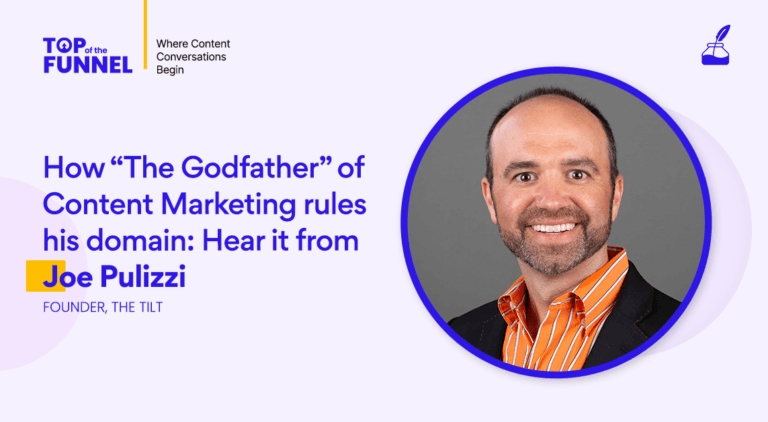
Expert Speak
18 mins read
Season 2 Episode #1 How “The Godfather” of Content Marketing Rules His Domain: Hear It From Joe Pulizzi
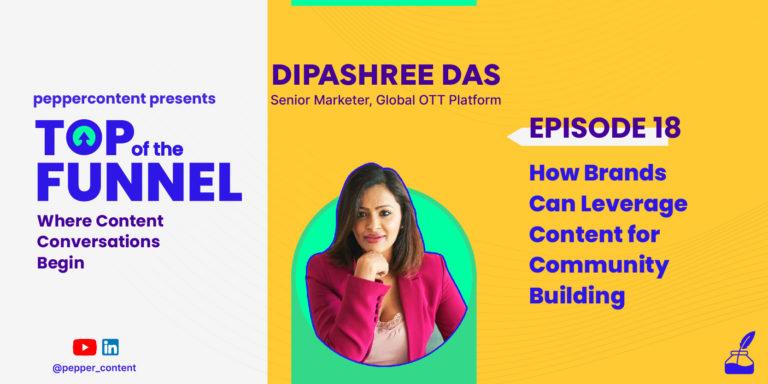
Expert Speak
16 mins read
Episode #18: How Brands Can Leverage Content for Community Building
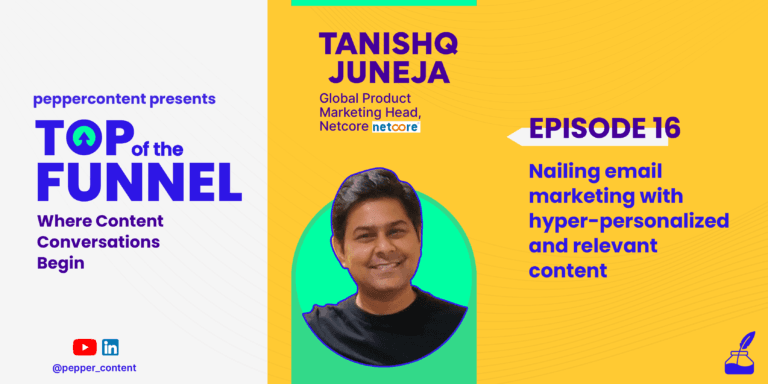
Expert Speak
16 mins read